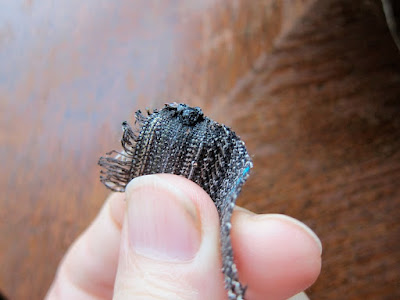
Friends, I hate to share fabric-related unpleasantness so early in the week, but not everything in life can be silk and cashmere. Or 100% wool. I can't remember what the sales clerk at Nahir, at 242 West 39th St., told me about this fabric. I think I knew it wasn't 100% wool. I'm just not sure I knew it was 0% wool.
(Maybe this is why their feedback is, well, you decide.)
I was so desperate to make a choice of fabric for my vintage Hollywood jumper pattern, part of my 1944 Outfit Project, that I probably wasn't asking the right questions or listening to the answers. The colors worked and it was within my (low) budget.


I noticed strange things about this fabric when I started to prep it. It never wrinkled. I also noticed, when I was ready to steam press/pre-shrink it, that it didn't have that distinctive wet wool smell. In fact, it had no smell at all. Did I mention that my beloved Black & Decker iron is starting to act up? Its little computer brain seems to be clinging to life -- but more about that later, if at all.
I decided to do a burn test. Lo and behold, the thing combusted like I'd soaked it in lighter fluid, and after I blew out the flames, formed a hard little bead. This can only mean one thing: polyester or some other petroleum-based synthetic, like acrylic.
I still like my fabric and it's very soft, but it ain't a natural fiber. Which is all well and good, I suppose, when you consider that the blouse it will be worn with is poly charmeuse. I've given up on historical accuracy here. But I must keep Cathy away from cigarettes, stove tops, and Bananas Foster -- no joke.

If you look at the selvage, you can see that this is a very loosely woven fabric, which means that it's shifty and ravely, not my favorite qualities, especially for a plaid. Fortunately, it's a balanced plaid (same design side-to-side, symmetrical when folded) and hence a bit easier to work with and match. Still, I've had challenges. The skirt has a center pleat, formed by folding back the center of two front panels six inches.
I didn't do a very good job of measuring, I guess, and this is what I got:


Fortunately, when you look at the fabric from more than a foot's distance, all you really see are the horizontal stripes, which have a bit of red or rust in them. Those match well.
Here's the front of the jumper:

The edges are finished with a narrow black cotton bias facing I cut myself. I'll whipstitch the inside edges.

Front pockets are also lined with black cotton.


Rather than use my serger, I overcast raw edges, which feels gentler and works just as well.

I've been using my trusty walking foot attachment on my Featherweight. I don't know if it really helps all that much, but it definitely doesn't hurt. Sewing plaid is stressful!

The skirt and jumper top are attached via a waistband, the inside of which is exposed (on the wrong side). I'll probably interface or underline it. The pattern calls for a snap closure on the left side of the skirt (I'll probably use a zipper) and hook-and-eyes on the waistband.
I like the jumper so far and it feels very period, but it hasn't been fun to sew. You can never relax with plaid, especially a loose, ravely, synthetic one like this.

Friends, that's all for today. Oh -- my iron. Last week I noticed it would turn itself on spontaneously when it was on auto off. Now I'm noticing the electronic display messes up every so often. It's frustrating, because mechanically the thing works fine, and it has performed flawlessly -- and constantly -- for the last two and a half years. I have a heavy vintage iron I bought and haven't used yet, but that would require a lot more vigilance, and a spray bottle.
Is there anything worse than a failing iron? You don't have to answer.
Now I must get back to my synthetic life...
Have a great day, everybody!
No comments:
Post a Comment